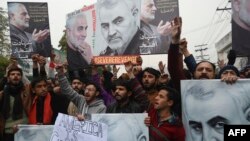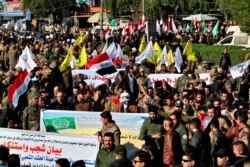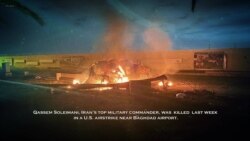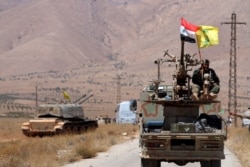The Iranian general who was killed last week in a U.S. airstrike in Baghdad, along with several Iranian-backed Iraqi militia leaders, was instrumental in expanding Iran's influence and reach beyond its borders through various proxy groups in the region.
Soleimani's unique skills crafting Iran's regional policy were rewarded in 1998 by the country's Supreme Leader Ayatollah Ali Khamenei, when he appointed him commander of the elite Quds Force, the external arm of the Islamic Revolutionary Guards Corps (IRGC), a U.S.-designated terror organization.
Soleimani's new job put him in direct contact with Tehran's proxy forces across the Middle East. In addition to strengthening Iran's alliance with powerful Shi'ite armed forces in the region such as Hezbollah, Soleimani helped forge new alliances in other countries.
To that end, the Arab Spring and the subsequent rise of Islamic State in 2014 in Iraq and Syria offered a new opportunity for Iran to push forward with its agenda in the region by forming and managing sectarian armed forces in both countries and beyond.
"For Soleimani, he had to go out there and pick the people who would be militarily most loyal and more effective," said Phillip Smyth, a research fellow at the Washington Institute for Near East Policy.
Networks
Smyth, who authored the Shi'ite Militia Mapping Project in 2019, told VOA that Soleimani relied on formal and informal relations to build his network of pro-Iranian Shi'ite militias that would answer directly to the IRGC.
In an attempt to increase Iranian military activity in the region following Soleimani's death, Khamenei on Tuesday approved legislation to add more than $200 million to the Quds Force's defense budget.
Hezbollah
The Shi'ite Lebanese militant group is considered the most powerful Iranian proxy in the Middle East. Founded in early 1980s, the group has built a significant armed wing, which has been responsible for many attacks against American and Israeli targets in the region.
During the Syrian civil war which started in 2011, Hezbollah played a key role in recapturing major cities and towns from Syrian rebels, including Homs and Aleppo. The group is reportedly in control of many parts of the Syria-Lebanon border.
Under the command of the Quds Force, Hezbollah has managed smaller Iranian-backed militia groups that have been active in Syria.
Experts say that over the years, Hezbollah has become so reliable for Iran that it has been assigned to carry out strategic tasks throughout the region.
"Hezbollah has always been used as an interlocutor when it comes to (pro-Iranian) groups, particularly in Iraq and Bahrain," Smyth said. "It was (Hezbollah chief) Hassan Nasrallah who fleshed out a possible Iranian response to the killing of Soleimani. He also set other new narratives that are being used by the group almost immediately."
In a speech Sunday, Nasrallah threatened to target U.S. military personnel in the Middle East in retaliation.
PMF
As the war on IS intensified, Iran, together with its loyal allies, including Shi'ite religious authorities in Iraq, began to form new Shi'ite militias that eventually came together under the umbrella of the Popular Mobilization Forces (PMF), also known as Hashd Shaabi.
While dozens of Shi'ite Iraqi armed groups operate under PMF's command, several have been prominent in their direct links to Tehran.
Kataeb Hezbollah, a Shi'ite group led by Abu Mehdi al-Muhandis who was killed with Soleimani in the airstrike, has received direct support from Iran and considers Khamenei its spiritual leader.
Members of Kataeb Hezbollah were among hundreds of people who attacked the U.S. Embassy in Baghdad in response to airstrikes in Iraq and Syria. The U.S. State Department designated the group a terrorist organization in 2009.
Asaib Ahl al-Haq
Asaib Ahl al-Haq (AHH) is another Iranian-backed Shi'ite militia that is largely active in Iraq, with some of its units fighting under the IRGC command in Syria.
Founded in 2006, the group has waged many attacks against U.S. forces in Iraq. Hours after Soleimani was killed, the State Department listed the AHH as a Foreign Terrorist Organization.
The Badr Organization, founded in 1983, is considered Iran's oldest proxy in Iraq, and perhaps the most powerful Shi'ite armed group in Iraq.
Reports say that since the onset of the war on IS in 2014, the Badr Organization has recruited more than 7,000 new fighters.
WATCH: A Look at Soleimani's Axis of Resistance
Afghan and Pakistani militias
To further strengthen Iran's grip on the region, some experts charge that the country also had to expand its ties with traditional allies. IRGC through Soleimani established Shi'ite brigades comprised of Afghan refugees and Pakistani Shi'ite to help tilt the ongoing Syrian civil war in favor of Syrian President Bashar al-Assad.
"As head of the IRGC's Quds Force, (Soleimani) was in charge of recruitment among Shi'ite populations of Afghanistan and Pakistan," said Farzin Nadimi, a Washington-based analyst specializing in Iran's security and defense.
Since 2011, Iran has sent thousands of Shi'ite Afghan refugees to Syria to fight alongside Syrian government forces, as well as other Iranian-backed Shi'ite militias.
The Afghan fighters are part of the Fatemiyoun Brigade, the second-largest group of foreigners fighting for Assad's regime in Syria. At the peak of the war, media reports estimated they numbered between 10,000 and 12,000 fighters.
Additionally, Iran has deployed thousands of Shi'ite Pakistani fighters to Syria. The Zeinabiyoun Brigade entered the Syrian conflict with the pretext of defending the Zainab bint Ali shrine.
It is unclear how many Pakistani fighters have joined the group, but experts say the group includes hundreds of Pakistani Shi'ites based in Iran.
In January 2019, the U.S. Treasury Department designated both groups terrorist organizations.
Experts say the presence of Iranian-backed Afghan and Pakistani militias in Syria exemplifies the core mission of the IRGC for dominance in the Middle East.
"With the Fatemiyoun and Zeinabiyoun in Afghanistan and Pakistan, (Iran) was largely successful as the numbers are truly (in the) thousands," said Alex Vatakna, an Iran expert at the Middle East Institute in Washington.
In both cases, he told VOA, the playbook was simple: "Bring onboard people that you can ideologically indoctrinate."
Shi'ites groups in Syria
With the Syrian military largely depleted, it sought more support from its Iranian and Russian allies. Iran's IRGC was quick to respond by forming dozens of small Shi'ite militias made up largely of Iraqi and Syrian nationals.
Some of these groups include the Imam al-Baqir Brigade, which mostly operates in central and eastern Syria; Liwa Abu Fadl al-Abbas, which has been operating in Damascus; and the Syrian Hezbollah, which is primarily made up of Shi'ite Syrians active in northwestern Syria, including Aleppo and Idlib.
Experts say these groups are paid by Iran and managed directly through its Quds Force.
Syrian government forces have relied on these fighters to maintain control over areas recently recaptured from Syrian rebel groups and IS militants.
Houthis in Yemen
Before the civil war in Yemen erupted in 2015, Iran was providing financial and military support to Houthi rebels who have been fighting forces loyal to Yemen President Abd-Rabbu Mansour Hadi's government.
Iranian support has reportedly helped Houthis capture large territories in Yemen, including the capital, Sanaa. Despite an ongoing Saudi-led military coalition in the war-torn country, Houthis have maintained their control of strategic parts of Yemen.
This is largely due to continued Iranian support, which would not be hindered by Soleimani's death, experts say.
"The support for Houthis will not be decreased significantly, even though Soleimani had his touch on each specific proxy group," said Matthew Levitt, director on counterterrorism and intelligence at the Washington Institute for Near East Policy.
"The network is in place, and certain people are in charge. The point person who provides financial and military (aid) for Houthis is the senior IRGC commander, Reza Shahlai, who (has been) listed recently in Rewards for Justice by the United States government," he told VOA.
VOA's Sirwan Kajjo, Niala Mohammad, Mehdi Jedinia, Ezel Sahinkaya, Nisan Ahmado and Nawid Orokzai contributed to this story from Washington.










